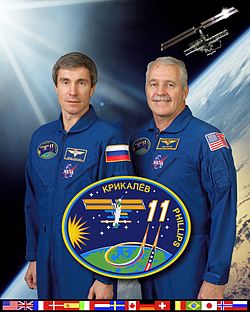Expedition 11
| Expedition 11 | |||
 | |||
| Uppdragsstatistik | |||
|---|---|---|---|
| Rymdstation: | ISS | ||
| Start: | 17 april 2005, 02:19 UTC[1] | ||
| Slut: | 10 oktober 2005, 21:49 UTC[1] | ||
| Tid: | 176 dag 19 tim 30 min | ||
| Antal besättningsmedlemmar: | 2 | ||
| Rymdpromenad | |||
| Antal rymdpromenader: | 1 st | ||
| Total tid: | 4 tim 58 min | ||
| Transport | |||
| Uppskjutning: | 15 april 2005, 00:46:25 UTC med Sojuz TMA-6 | ||
| Uppskjutningsplats: | Kosmodromen i Bajkonur | ||
| Landning: | 11 oktober 2005, 01:09:00 UTC med Sojuz TMA-6 | ||
| Landningsplats: | 85 km NÖ om Arkalik, Kazakstan | ||
| Kronologi | |||
| |||

Expedition 11 var den 11:e expeditionen till Internationella rymdstationen (ISS). Expeditionen började den 17 april 2005 då Expedition 10s besättning återvände till jorden med Sojuz TMA-5. Expeditionen avslutades den 10 oktober 2005 då Sojuz TMA-6 återvände till jorden med Expedition 11s besättning.
Under Expedition 11 levererade rymdfärjan Discovery under flygningen STS-114, förnödenheter till rymdstationen. STS-114 var den första flygningen av en amerikansk rymdfärja efter haveriet av Columbia under återinträdet i jordens atmosfär under STS-107 flygningen den 16 januari 2003.
Besättning
| Position | (17 april - 10 oktober 2005) |
|---|---|
| Befälhavare | Hans sjätte rymdfärd |
| Flygingenjör 1 | Hans andra rymdfärd |
Referenser
- ^ [a b] NASA's Space Station Expedition 11, läst 28 augusti 2016.
Externa länkar
| |||||||||||||||||||
Media som används på denna webbplats
The Expedition 12 patch represents both mankind's permanent presence in space and future dreams of exploration. The International Space Station (ISS), featured prominently in the center, will continue to grow in its capability as a world-class laboratory and test bed for exploration. The vision of exploration is depicted by the moon and Mars. The star symbolizes mankind's destiny in space and is a tribute to the space explorers who have been lost in its pursuit. The Roman numeral XII in the background signifies the 12th expeditionary mission to the ISS.
The Expedition 10 patch uses simple symbolism to describe the mission. The large Roman numeral "X," formed by the American and Russian flags, symbolizes the joint nature of this mission, as well as the fact that this flight is the 10th mission to stay on the International Space Station (ISS). The current configuration of the ISS is next to the name of the ISS Commander, while the Soyuz vehicle is placed next to the name of the Soyuz Commander. The single star and the black background signify this is a space mission.
ISS Expedition 11 insignia.
The emblem of the eleventh expedition to the International Space Station (ISS) emphasizes the roles of the United States and the Russian Federation in the multinational ISS partnership. The two rocket plumes, in the style of the flags of these two nations, represent the Russian Soyuz vehicles and the American Space Shuttles. The ISS image shows the configuration of the orbiting Station at the start of the expedition, with docked Soyuz and Progress vehicles and the huge American solar panels. The names of the two crew members are shown on the margin of the patch. ISS Commander Sergei Krikalev and John Phillips, NASA ISS science officer and flight engineer, are expected to launch on a Soyuz vehicle and to be in orbit during the return to flight of the Space Shuttle. The crew explains, “The beauty of our home planet and the vivid contrasts of the space environment are shown by the blue and green Earth with the Space Station orbiting overhead, and by the bright stars, dark sky, and dazzling sun.”





